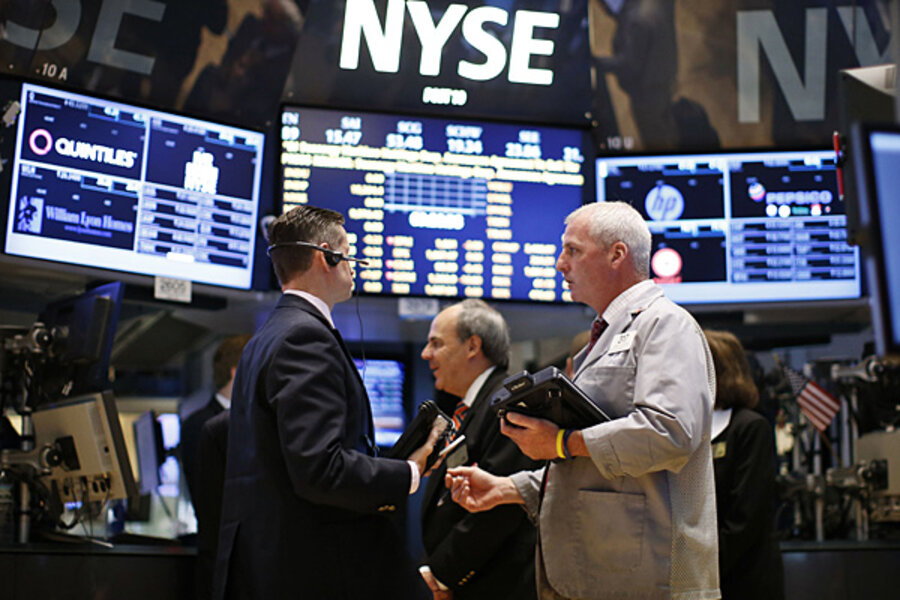Stocks mixed in slow start to week
Loading...
| New York
Small-company stocks were a bright spot in a slow and choppy start to the week for Wall Street.
The Russell 2000, an index of small-company stocks, climbed above 1,000 points for the first time and ended higher Monday, even as the Dow Jones industrial average, the Standard & Poor's 500 index and the Nasdaq composite index all edged lower.
Small stocks are doing well because they are more focused on the U.S., which is recovering, and are less exposed to recession-plagued Europe than the large international companies that make up the Dow and the S&P 500 index.
The gains for the smaller companies are encouraging for the broader stock market because they show that investors are becoming more comfortable about the economy and investing in riskier assets, said Rob Lutts, Chief Investment Officer at Cabot Money Management.
Small-company stocks are considered riskier than the stocks of well-established, large companies like IBM or Coca-Cola. That's because small companies are often relatively young and tend to have less diversified businesses than larger ones, making them more susceptible to swings in demand from their customers. There are also fewer buyers and sellers for them, which can make the stocks harder to off-load if prices start to fall.
"Having smaller stocks hit new highs means that the rally is broad," Lutts said. "It gives us a little more confidence that it's a good, sustainable rally that can hold together for a while."
The Russell 2000 ended the day 1.70 points, or 0.2 percent, higher at 997.98. The index climbed as high as 1001.50 at midday. The index is 17.5 percent higher for the year, a better performance than better-known market barometers like the Dow and S&P.
Major indexes fluctuated between small gains and losses for most of Monday. On Friday they ended at record levels after four straight weeks of gains.
The Dow closed down 19.12 points, or 0.1 percent, at 15,335.28, paring its gain for the year to 17 percent. The S&P 500 index fell 1.18 points, or 0.1 percent, to 1,666.29. Its advance for the year now stands at 16.8 percent.
Investors are focusing on the Federal Reserve this week and looking for clues about what it plans to do next with its economic stimulus program. On Wednesday Fed Chairman Ben Bernanke will appear before Congress and the central bank will release minutes of its most recent policy meeting.
The Fed is buying $85 billion of bonds every month to keep long-term interest rates low. That has encouraged investors to put money into stocks instead of bonds. The yield on the 10-year Treasury note has been below 2 percent almost continually since April 12. That's less than many large companies pay in dividends.
Policy makers are unlikely to cut back on stimulus just yet since U.S. economic growth is likely to slow in the second quarter, said Scott Wren, a senior equity strategist at Wells Fargo Advisors. As a consequence, Wren said, stocks are likely to continue to rise.
"At some point, we will see some sort of a pullback, but it doesn't seem like it's going to be right now," said Wren. "In the near term we're probably going to trade a little bit higher."
The stock market rally is also is being underpinned by investors moving back into stocks, reversing years of outflows of funds from equity markets, said Jerry Braakman, chief investment officer at First American Trust.
Investors have invested about net $17 billion into domesticstock mutual funds since the start of the year, according to data from the Investment Company Institute. Investors have pulled money out of mutual funds every year since the beginning of the financial crisis in 2007.
"This market rally still has legs, partly because we've seen huge retail inflows back into equities," Braakman said. "It's hard to beat the money flow."
In commodities trading, the price of crude oil rose 69 cents, or 0.7 percent, to $96.71 a barrel.
The price of gold rose for the first day in eight as the dollar fell. The precious metal climbed $19.40, or 1.4 percent, to $1,384. Gold has slumped this month as its attraction as an alternative investment fades as the dollar appreciates.
The U.S. currency is strengthening because investors believe the U.S. economy is in better shape than the Japanese or European economies.
The dollar's rally paused on Monday, though, and the U.S. currency fell against the euro and the yen. The dollar index also dropped, after climbing to its highest level in close to three years Friday.
In U.S. government bond trading, the yield on the 10-year Treasury note rose to 1.97 percent from 1.93 percent.
The Nasdaq composite index fell 2.53 points, or 0.1 percent, to 3,496.43 points.
Among stocks in focus on Monday:
— Actavis rose $1.65, or 1.3 percent, to $127.15 after the pharmaceutical company said it's buying Warner Chilcott. The all-stock deal, valued at $8.5 billion, would create the third-biggest specialty pharmaceutical company in the U.S.
— Chesapeake Energy rose 53 cents, or 2.6 percent, to $20.80 after the natural gas producer named Anadarko Petroleum executive Robert Douglas Lawler as its new CEO. He takes over as Chesapeake continues selling assets to pare down an enormous debt burden.
—Websense, an internet security firm, surged $5.53, or 29 percent, to $24.76 after the company agreed to be taken private for $906 million by private equity firm Vista Equity Partners.







